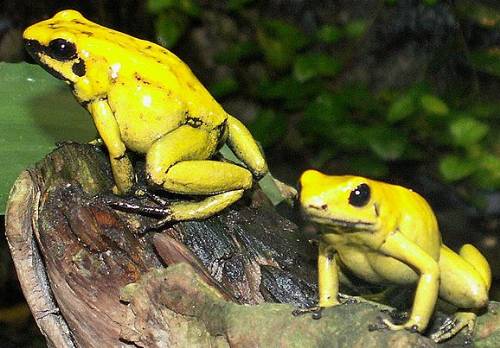Golden Poison Frog
Phyllobates terribilis
|
|

|
|
Golden Poison Frog (Phyllobates terribilis) Image: Marcel Burkhard |
The Golden Poison Frog is native to the lowland rainforests of the Pacific coast of Colombia. It's the most toxic of the poison dart frogs (Family Dendrobatidae) and is said to be the most poisonous animal on earth. Merely touching it can result in instant death.
Its skin is coated with an alkaloid neurotoxin known as batrachotoxin, which prevents nerves from transmitting impulses and therefore induces a permanent state of contraction in muscles. The result is heart failure. A single gram of this toxin would suffice to kill 15,000 human beings. Supposedly, the amount present on the skin of a single frog is enough to kill two elephants. Batrachotoxin acts far more quickly than some of the neurotoxins produced by other venomous animals, for example, that produced by black widow spiders.
Like other poison dart frogs, the toxicity of P. terribilis depends on diet. Captive frogs, without access to the prey eaten in the wild, are not poisonous. Batrachotoxin, then, is either produced originally by certain prey eaten by poison frogs, or they themselves convert some substance derived from their prey into the toxin.
The frogs are, of course, immune to their own poison, and they can store it for years, even after being deprived of its food-based source. Batrachotoxin does not easily deteriorate, even when placed on an inanimate surface. So it's perilous to come into contact with anything touched by these frogs. Some indigenous peoples of Colombia use batrachotoxin to coat hunting darts.
Batrachotoxin is known only in three poisonous frogs of the genus Phyllobates, all native to Colombia, and in the three known poisonous birds (all residing in Papua New Guinea: Pitohui dichrous, Pitohui kirhocephalus, and Ifrita kowaldi).
Golden poison frogs are social animals
In the wild these frogs usually live in groups of about half a dozen individuals, who interact constantly with each other. They communicate not only with their calls, but also by movement and gesture. Lifting the body upwards indicates dominance. Lowering it indicates submission.
Wikipedia states that
Golden poison frogs are attentive parents. Unlike most frogs, they lay their eggs on the ground and then stand watch. When the tadpoles emerge, they crawl up and attach themselves to their parents' backs. The adult frogs then carry them up into the canopy and place them in one of the small pools of water that form there, either in tree hollows or in the recesses of certain epiphytes such as bromeliads. There the tadpoles remain, eating algae and the larvae of insects, until metamorphosis is complete. Their parents then return to lead the young frogs to the local group of adults.
Return to Dictionary >>
Most shared on Macroevolution.net:
Human Origins: Are we hybrids?
On the Origins of New Forms of Life
Mammalian Hybrids
Cat-rabbit Hybrids: Fact or fiction?
Famous Biologists
Dog-cow Hybrids
Georges Cuvier: A Biography
Prothero: A Rebuttal
Branches of Biology
Dog-fox Hybrids